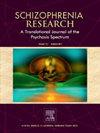Machine learning prediction model of the treatment response in schizophrenia reveals the importance of metabolic and subjective characteristics
IF 3.6
2区 医学
Q1 PSYCHIATRY
引用次数: 0
Abstract
Predicting early treatment response in schizophrenia is pivotal for selecting the best therapeutic approach. Utilizing machine learning (ML) technique, we aimed to formulate a model predicting antipsychotic treatment outcomes. Data were obtained from 299 patients with schizophrenia from three multicenter, open-label, non-comparative clinical trials. For prediction of treatment response at weeks 4, 8, and 24, psychopathology (both objective and subjective symptoms), sociodemographic and clinical factors, functional outcomes, attitude toward medication, and metabolic characteristics were evaluated. Various ML techniques were applied. The highest area under the curve (AUC) at weeks 4, 8 and 24 was 0.711, 0.664 and 0.678 with extreme gradient boosting, respectively. Notably, our findings indicate that BMI and attitude toward medication play a pivotal role in predicting treatment responses at all-time points. Other salient features for weeks 4 and 8 included psychosocial functioning, negative symptoms, subjective symptoms like psychoticism and hostility, and the level of prolactin. For week 24, positive symptoms, depression, education level and duration of illness were also important. This study introduced a precise clinical model for predicting schizophrenia treatment outcomes using multiple readily accessible predictors. The findings underscore the significance of metabolic parameters and subjective traits.
精神分裂症治疗反应的机器学习预测模型揭示了代谢和主观特征的重要性。
预测精神分裂症的早期治疗反应是选择最佳治疗方法的关键。利用机器学习(ML)技术,我们旨在建立一个预测抗精神病药物治疗结果的模型。数据来自299例精神分裂症患者,来自三个多中心、开放标签、非比较临床试验。为了预测第4、8和24周的治疗反应,评估了精神病理(客观和主观症状)、社会人口学和临床因素、功能结局、对药物的态度和代谢特征。应用了各种ML技术。第4周、第8周和第24周曲线下面积(AUC)最高,分别为0.711、0.664和0.678。值得注意的是,我们的研究结果表明,BMI和对药物的态度在预测治疗反应方面起着关键作用。第4周和第8周的其他显著特征包括心理社会功能、阴性症状、精神和敌意等主观症状以及催乳素水平。在第24周,阳性症状、抑郁、教育水平和疾病持续时间也很重要。本研究引入了一种精确的临床模型来预测精神分裂症治疗结果,使用多种容易获得的预测因子。这些发现强调了代谢参数和主观特征的重要性。
本文章由计算机程序翻译,如有差异,请以英文原文为准。
求助全文
约1分钟内获得全文
求助全文
来源期刊

Schizophrenia Research
医学-精神病学
CiteScore
7.50
自引率
8.90%
发文量
429
审稿时长
10.2 weeks
期刊介绍:
As official journal of the Schizophrenia International Research Society (SIRS) Schizophrenia Research is THE journal of choice for international researchers and clinicians to share their work with the global schizophrenia research community. More than 6000 institutes have online or print (or both) access to this journal - the largest specialist journal in the field, with the largest readership!
Schizophrenia Research''s time to first decision is as fast as 6 weeks and its publishing speed is as fast as 4 weeks until online publication (corrected proof/Article in Press) after acceptance and 14 weeks from acceptance until publication in a printed issue.
The journal publishes novel papers that really contribute to understanding the biology and treatment of schizophrenic disorders; Schizophrenia Research brings together biological, clinical and psychological research in order to stimulate the synthesis of findings from all disciplines involved in improving patient outcomes in schizophrenia.
 求助内容:
求助内容: 应助结果提醒方式:
应助结果提醒方式:


